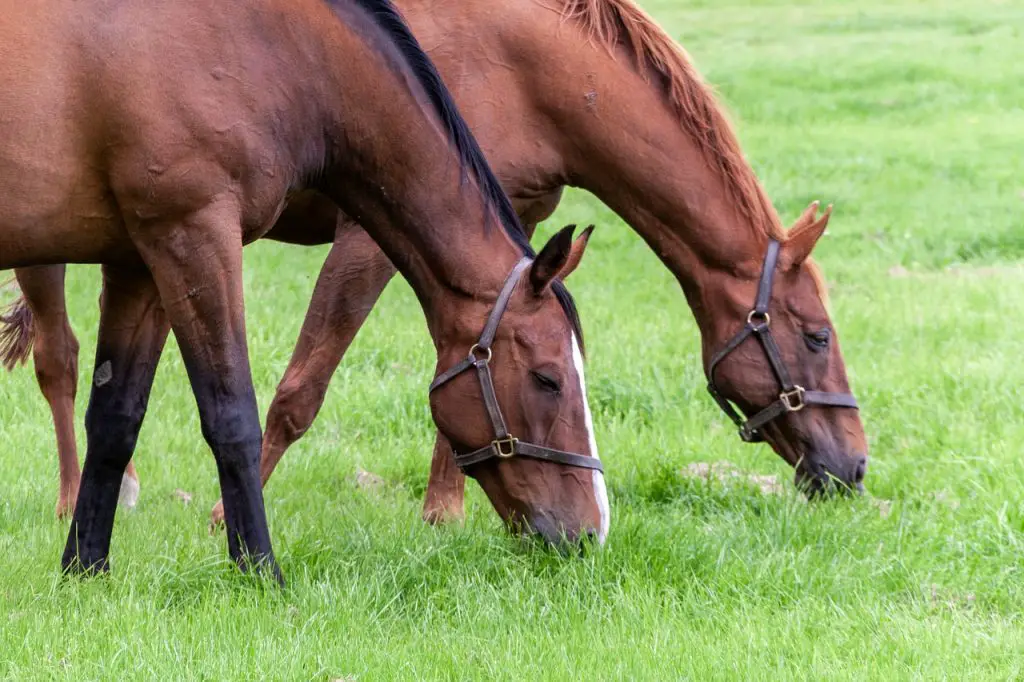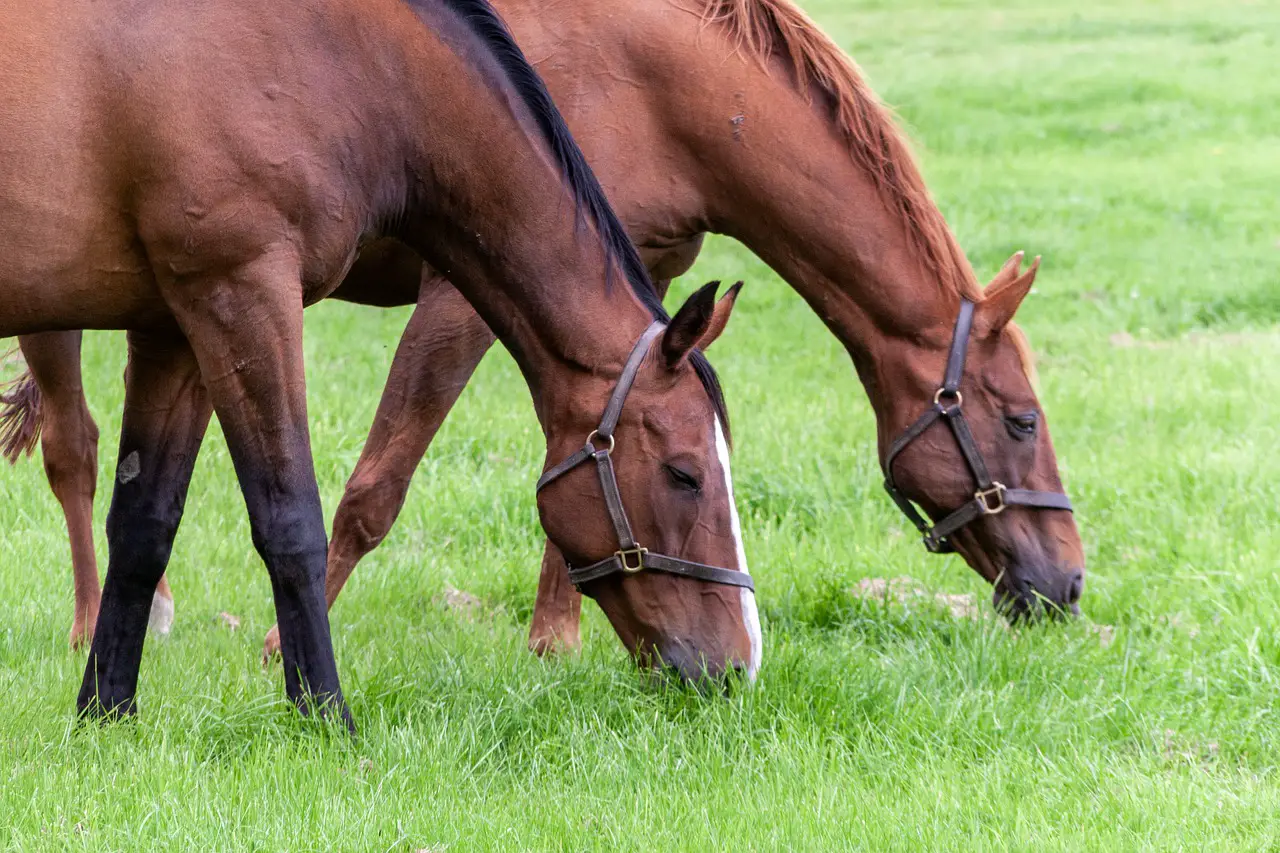Last Updated on February 21, 2022 by Allison Price
100 years ago, horses were easy to feed. A farmer or trainer would go to the feed shop and buy a bag of corn or oats for their horses. Horse owners today face a daunting task in nutrition management. They are faced with an almost endless array of sweet feeds and pelleted feeds as well as extruded products. Supplements to nourish and enhance each horse’s mind or body is also a challenge. Even the traditional oat diet is complicated. While feed mills still provide whole oats for their horses, owners can request crimped, cracked and crushed oats as well as rolled, steamed or roasted oats.
New horse owners often seek advice from more experienced horse owners about feed management. This practice can lead to conflicting information. A good consultation with a feed dealer will usually reveal that there are at least one and most likely many “right choices” for every horse.
Horses should eat forage (grass and hay) as the main food source. However, horses may require supplemental energy to grow, exercise or reproduce.
Each feed type can provide energy. Owners should also consider other characteristics when choosing the right feed for their animal. It is important to consider the pros and cons of every type of feed before making a decision.
“All my horses love sweet food. “Even picky eaters can clean up all the sweet feed.” Sweet feed is bad news for horses. It’s just sugar strong>
In the early 20th century, feed traders combined oats with corn and barley and added salt. They also used molasses to bind the mixture together and called it “sweet feed.” Owners bought sweet feed because it looked good and smelled nice. Sweet feeds of today still get approval from owners and horses. However, they are now available in many different formulations to suit the needs of nearly any horse.

Sweet feed, also known as textured feed, has a major advantage: It is very easy to digest. Sweet feed is accepted by most horses and is therefore a great choice for horses that are prone to rejecting other feeds. Molasses is a sticky byproduct of sugarcane production. This is part of its appeal. Research has shown that molasses can cause a rapid rise in blood glucose, which is a danger to horses. This reaction is linked to an increase in the incidence of skeletal problems, especially in horses that are young. Molasses is the most common sweetener in sweet feed. This has made it a target for people who want to blame molasses for feeding problems. Although molasses is a sugary ingredient, modern sweet feed products have lower sugar levels than the ones of years past. As with all feed-related conditions, it is important to manage the problem. Concentrated grain products should not be allowed to horses of all ages, regardless of their molasses content. Sweet feeds can vary according to region, season, manufacturer and intended use. Many sweet feeds for young horses have a lower carbohydrate content to reduce developmental problems.
There are many ingredients that can be used to make sweet feeds. To increase energy and decrease starch, sweet feed manufacturers might add vegetable oil, beet pulp, or soy hulls. Sweet feed can also include vitamin E for digestion, herbs, flavorings, and balancer pellets (proteins, vitamins and minerals) for nutrient enhancement. Other additives help prevent mold growth and reduce the likelihood of feed clumping in colder weather. The range for protein levels is usually between 12 and 16 percent, but fat and fiber can vary greatly among formulations. There are many options available so owners can choose a sweet feed that suits their horse, regardless of his age, breed, or use.
“Pellets provide everything I need for my gelding. They won’t mold in summer and are easy to manage in winter.
“It’s okay to not feed pellets. Heat processing damages all vitamins strong>
Pellets have the same advantages and disadvantages as other forms of feed. Many owners will list digestibility, uniformity, as well as ease-of-handling in the “plus” column. Many arguments against pellets are false, including questionable ingredients and nutrient loss during manufacturing. There is also a greater danger of choking. Pellets are made from the same ingredients that sweet feed, including corn, oats and barley as well as vitamins, minerals and molasses. What the components are combined makes them look different. The ingredients are combined into a slurry, then the mixture is subject to steam heating. This heat increases the nutrients’ availability as they pass through horses’ digestive tract. After the mixture is forced through pellet dies it is cooled and bagged. Although starchy grains are easier to digest through heat-processing, some nutrients can be destroyed by prolonged exposure to high temperatures. Manufacturers often increase the amount of heat-sensitive vitamins in order to compensate for this loss. You can also make pellets using a cold-process technique to eliminate the loss of essential nutrients.
The fact that the ingredients are mixed means that picky horses cannot sift through the feed and eat what they like, leaving behind less desirable scraps. The argument from detractors is that top-dressed supplements stick to sweet feed, so they are eaten. However, the same powders and granules end up in the bottom. This problem can be solved by adding a small amount of vegetable oil to each serving of pellets.
Horses that eat pelted feeds are said to be prone to choking. Horses that eat too quickly can choke on any type or feed. A pelleted diet can be made easier by adding water to it. This will soften the feed and provide some lubrication for easy swallowing. Choke-prone horse owners can resort to the tried-and-true solution of placing large, smooth rocks in their feed tubs to slow down consumption and limit the size each bite.
Pellets can be made into sweet feeds in many different forms. The levels of protein and fat as well as fiber will vary depending on the manufacturer and intended use. Formulations for young horses typically have the highest levels of protein, while feeds designed to fuel endurance horses may contain oil as an “cool” energy source. Molasses is also found in pellets, but it is less than in sweet feed.
“Have ya seen the new extruded feed?” It’s almost like Cheerios!
It may look different, but older horses can chew and digest extruded feed .”
Extruded horse feed is a newer form that looks similar to other pet foods. Extruded feeds are made from the same ingredients found in textured and pelleted products. They consist of small chunks that are crispy, crunchy, and slightly shiny.
Extruded feed encourages horses’ to chew their food more deeply, making them more likely to eat it. Extruded feed is made by heating and pressure. This process results in the easiest to digest feed. This is a benefit for seniors horses and those with dental issues. Extruded feeds have the lowest amount of dust, making them a good choice for horses suffering from respiratory issues. Extruded feeds are more costly to make and may not be as popular as traditional feeds.
What’s wrong in plain oats or something natural? This is what my grandpa ate, and this is what I eat, too.
“Oats? You’re kidding! You’re kidding!
Oats is the most traditional horse feed. Oats are a common choice for horses, as they are easy to digest and have low starch levels. This reduces the chance of colic. Oats do not contain enough lysine. This amino acid is crucial for young horses’ growth. The mineral profile of young horses is heavily influenced by phosphorus. This can threaten their health and prevent them from achieving a healthy skeletal maturity.
Broodmares require large amounts calcium to produce milk. This is not possible with an oats-only diet. For most horses, fortified feeds are better than straight grains because they provide a complete nutritional profile.
“I don’t give my pony any grains at all. He is too fat and I cannot work him as his feet are in terrible shape.”
“Have yu tried one of the concentrated, low-calorie nutritional supplements strong>
Some equines do not require much grain. A low-calorie vitamin supplement may be beneficial for the pony with a fat hoof. Other horses may require more energy, vitamins and minerals than can be obtained from grass or hay. Traditional concentrates are not the best solution due to medical or genetic conditions like tying up, insulin resistance, or HYPP. Horses who tie up often show dramatic improvements in their exercise tolerance when given special feeds low in starch, high in fat, and fermentable fiber like REVEL.
Although these horses may appear unique, they are just extreme examples of how each horse should be treated as an individual. How can an owner figure out the best way to care for each horse in her care?


